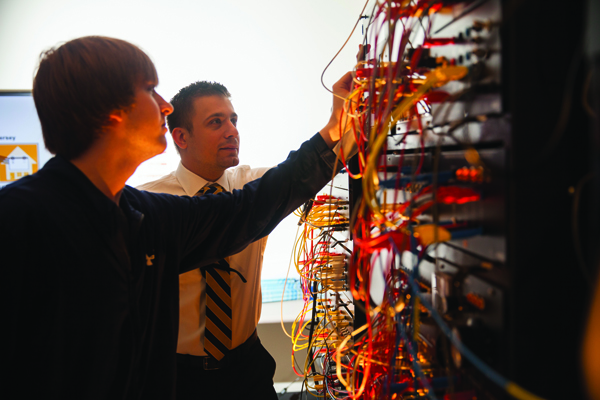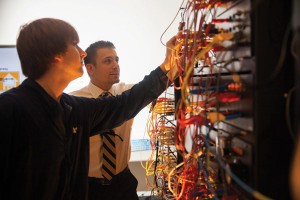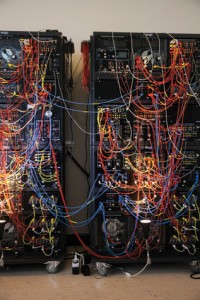Powering the future
A new lab on campus is fueling research in smart energy conversion, distribution, and utilization.


At first glance, TCNJ’s Smart Electric Power System (SEPS) Laboratory, which is tucked away inside a nondescript Armstrong Hall classroom near the campus’s northwest corner, doesn’t look like anything special. Inside the windowless room, a bank of six Dell laptops sit side by side underneath a 60-inch LED screen, while off to one side stand three six-foot-high towers of electronics hardware interconnected with enough red, yellow, blue, and white wires to give even the most devoted A/V enthusiast nightmares. But its utilitarian appearance aside, the lab is a thing of beauty to faculty and students in TCNJ’s small but growing power engineering program. It’s a prototype of next-generation power grid technologies, and it enables TCNJ researchers to do innovative work aimed at addressing the growing global need for smart energy conversion, distribution, and utilization.
Funded through a National Science Foundation grant, the lab’s equipment constitutes an electrically scaled model of a smart power system, complete with components that represent solar cells, wind turbines, commercial and residential loads, and digital controls, as well as fossil fuel–based generators like those used in today’s traditional grid. “It’s a view of what power systems will hopefully look like in 20 years,” says Assistant Professor of Electrical and Computer Engineering Anthony Deese, who directs the lab and was the primary investigator on the grant. “This laboratory allows TCNJ faculty and students to manipulate a power system with a robust mix of advanced renewable energy, battery storage, and digital control technologies, far more robust than exists in physical systems today.”
The SEPS lab will allow TCNJ to play a leading role in educating the next generation of power systems engineers—people who will design, implement, and utilize the smart grid technologies needed to modernize the country’s aging power grid infrastructure, and who will fill an impending brain drain expected to hit the utilities industry as a large portion of its engineering workforce nears retirement.
A smart power innovation center
This past summer, President Barack Obama called on the country to double its use of electricity from solar, wind, and geothermal sources by the year 2020. One of the challenges with meeting that demand is that much of the current grid is not set up to generate and transmit power from “green” sources. Smart grid technologies—which, among other things, allow bulk storage of energy obtained from renewables, are more automated, and provide a more reliable, flexible network—will need to be implemented on a large scale if Americans are going to increase their reliance on renewable energy.

That means major changes are in store for the nation’s current power grid, the evolution of which has been very slow, says Deese. “Because our society is so sensitive to, and intolerant of, even short power outages, it is difficult for engineers to design and test new power system technologies aggressively. No solution is transferred from drawing board to real-world with 100 percent reliability.”
Drawing an analogy to Internet infrastructure, Deese points out how Internet service providers routinely test new routing protocols with little or no ramifications. “If Internet service is lost for 10 minutes, customers won’t notice or will spend that time resetting their wireless routers. A one-minute interruption in power service, however, might be discussed on the evening news. Therefore, it is difficult for independent system operators and utilities to test and implement new smart technologies because there is no room for error.”
By providing access to emerging smart grid technologies—including photovoltaic cells, wind turbines, Ni-MH battery storage, solid-state power electronic converters, and embedded data acquisition/actuation capability—the SEPS lab provides TCNJ researchers a test-bed that emulates the structure and behavior of an electric power system, so they can manipulate the parameters and topology of the system and observe the effects of their actions. “We can implement our own algorithms…or build our own devices and attach them to the system to see how they work,” says Deese. “We can do destructive-type testing that you wouldn’t be able to do with a real power system.”
Creating a pipeline of smart power engineers
Power systems engineering courses were once the cornerstone of college and university electrical engineering programs across the country. But during the last few decades, the field of study was neglected as many researchers turned their interests toward digital technologies and computers. “People saw power engineering as, ‘Okay, we’ve done that. It works. There’s not really anything new to do anymore,’” Deese said.
But with the need to find innovative ways to generate and transmit power from green sources, there has been renewed interest in the field. At the same time, a gap in the workforce is expected in the coming years. (A 2009 U.S. Power and Energy Engineering Workforce Collaborative report estimated that almost half of the country’s electric power and energy engineers would be retiring by 2014.) TCNJ’s commitment to expanding its power-engineering program will create a pipeline of skilled graduates who can answer these needs, says Deese. And the SEPS lab will play a key part in that enterprise.
“TCNJ is unique. There aren’t many undergraduate institutions that have advanced power system and smart grid laboratory hardware,” says Deese. “There also aren’t many institutions that put this kind of emphasis on the role of undergraduate research in power and energy engineering education that TCNJ does. We’re showing other institutions that not all advanced engineering work needs a large graduate program, especially in the field of power and energy.”
Posted on December 11, 2013

